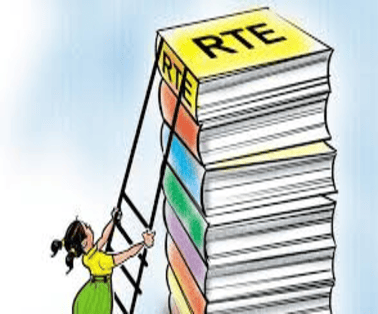Maharashtra has recently introduced changes to the Right to Education (RTE) Act, altering private school admission policies. This move makes Maharashtra one of the latest states to modify RTE Act rules, potentially limiting access to private schools for students from disadvantaged backgrounds.
Key Changes in Maharashtra’s Right to Education Rules
- The new rule states that the “local authority shall not identify the private unaided school, for the purposes of 25 per cent admission of disadvantaged group and weaker section under the Maharashtra Right of Children to Free and Compulsory Education Rules, 2013, where government schools and aided schools are situated within one-kilometre radius of that school.”
- This means that private schools within a 1 km radius of a government or government-aided school (which receives money from the government) will no longer have to observe the 25% requirement.
- Instead, students in these neighbourhoods will be considered for admission into said government or aided schools first.
- This exemption would also apply to private schools established in the future, as long as they are built within a 1 km radius of a government or aided school.
- In case there are no government or aided schools in the vicinity, the notification states that private schools will be identified for RTE admissions.
Other States Implementing Similar Right to Education Changes
- With this new rule, Maharashtra has joined Karnataka and Kerala as states that have imposed this new regime to exempt private schools from providing RTE admissions.
- Karnataka introduced the rule in December 2018, and specifically referenced the Kerala rules which were introduced in 2011.
- In Kerala, the fee concession for students is only made available to RTE quota students if there are no government or aided schools “within walking distance”, which is 1 km for students joining in Class 1.
- Karnataka’s state law minister stated in 2018 that the RTE’s main aim is to offer education to all students, noting that the state’s previous policy of permitting parents to enrol children in private schools near government schools had drastically reduced government school enrolments.
- The Karnataka government’s 2018 gazette notification is currently under judicial scrutiny.
- Private schools and teachers’ organisations have noted that state governments frequently fail to reimburse fees for students admitted under this quota, as mandated by Section 12(2) of the RTE Act, which requires state governments to reimburse schools per-child expenses or the fee amount, whichever is lower.
Impact of the New RTE Act Exemptions
- The primary reasons for introducing these exemptions are concerns about a decline in enrolment ratios in government schools.
- The amendment closes the window for marginalized students to access quality education in private schools.
- The RTE Act aims to contest education apartheid and promote equality by providing opportunities to disadvantaged children, the recent rules dilutes the core of the Act.
- There are concerns in delay and pending payments from State have been reported in various states, including Maharashtra.
- It placed a financial burden on private schools as the State did not provide payment in timely manner, even if they provide it is not adequate to meet the financial needs of the education.
Understanding the RTE Act: A Milestone for Right to Education in India
- In the 1993 case of Unnikrishnan vs. State of Andhra Pradesh, the Supreme Court ruled that the citizens of this country have a fundamental right to education. The said right flows from Article 21.
- The Supreme Court also noted that the right to education was not an absolute right and ruled that every citizen of India should have the right to free education until 14 years of age.
- The Right to Education serves as a building block to ensure that every child has his or her right to get a quality elementary education.
- The first official document on the Right to Education was Ramamurti Committee Report in 1990.
- Tapas Majumdar Committee (1999) was set up, which encompassed insertion of Article 21A.
- The 86th amendment to the constitution of India in 2002, provided Right to Education as a fundamental right in part-III of the Constitution.
- The same amendment inserted Article 21A which made Right to Education a fundamental right for children between 6-14 years.
- The 86th amendment provided for a follow-up legislation for Right to Education Bill 2008 and finally Right to Education Act 2009.
Key Features of the Right to Education Act
- Children aged 6-14 years are entitled to free, compulsory education in local schools, with enrollment in an age-appropriate class for those above 6 not in school.
- Aided schools must also offer education for free, proportionate to their funding, but not less than 25%.
- Elementary education is free until completion, and no child can be held back, expelled, or required to pass a board exam before finishing elementary education.
- An academic authority designated by the central or state government must develop the curriculum and evaluation procedure for elementary education.
- All schools required to adhere to pupil-teacher ratio norms and meet prescribed standards before establishment or recognition
- Teacher qualification to be ensured by the Teacher Eligibility Test (TET) conducted by the appropriate government.
- Teachers are forbidden from giving private tuition or performing non-teaching tasks, except for census, disaster relief, and election duties.
- Schools must establish School Management Committees (SMCs)consisting of local authority representatives, parents, guardians, and teachers to oversee the school’s use of government funds and create a school development plan.
- The National Commission for the Protection of Child Rights reviews safeguards and investigates complaints, with powers akin to a civil court; the state government may also establish a State Commission for similar functions.
- Any child with disabilities will also have the right to access free and compulsory education at par with children with disabilities
- Both the Central Government and the state governments share concurrent responsibility for providing and sanctioning funds to enforce and carry out the provision of the Act.
- No school fee, capitation fee, charges or expenses to be borne by the child to get elementary education.
The Right to Education Act: Challenges & The Road Ahead
While the RTE Act is a significant step toward inclusive education, recent amendments in Maharashtra and other states highlight ongoing challenges:
- Financial Constraints: Delayed reimbursements have deterred private schools from supporting Right to Education admissions.
- Unequal Implementation: Some states enforce the RTE Act more rigorously than others, leading to inconsistencies in access.
- Quality vs. Accessibility: Government schools often lack resources, making the shift from private to public institutions under the new rules a concern.
The Right to Education Act remains a crucial pillar of India’s education system, but amendments like Maharashtra’s raise questions about its long-term effectiveness in ensuring equitable education for all.
To Download Monthly Current Affairs PDF Click here
Click here to get a free demo
Discover all about CLAT Exam



